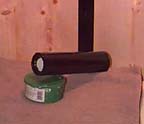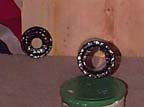
![]()

 These instructions are presented here for informational purposes
only. Any modifications you choose to do to your gun, you do so at your
own risk. Be sure to REMOVE the CO2 or other gas source from any paintball
marker before you attempt disassembly. Wear eye protection when using ANY
power tools. If unsure about safely modifying your gun, consult a professional
airsmith. Remember, safety must ALWAYS come first! These instructions are presented here for informational purposes
only. Any modifications you choose to do to your gun, you do so at your
own risk. Be sure to REMOVE the CO2 or other gas source from any paintball
marker before you attempt disassembly. Wear eye protection when using ANY
power tools. If unsure about safely modifying your gun, consult a professional
airsmith. Remember, safety must ALWAYS come first! |
![]()
Submitted by Chris (aka Sugar Ray)
Stingray I Custom Barrel Shroud (Volume Control)
 1. Item
Created - Custom Stingray I barrel shroud (rumored to have quieting effect)
1. Item
Created - Custom Stingray I barrel shroud (rumored to have quieting effect)
2. Expected results - Replace the old Stingray barrel shroud with a cooler looking one. It will have an aggressive and intimidating look. It will also quiet the sound report of a firing Stingray that has a ported or muzzle-breaked barrel.
3. Materials - 2" PVC piping (a 1 foot section will do), 2" PVC Test Caps (need 2 of these), hack saw, piece of foam rubber pad (1 ft. square pad will do), X-Acto knife, sand paper, Black or Camo duct tape or electrical tape, electric drill, Dremel with high speed cutter (optional)
4. Description - This version works with a stock length Stingray I barrel. It will work with other barrels and with the Ray II. The differences necessary to change the shroud to fit would be in the length and the end caps.
Mark the PVC pipe at 9 and one quarter inches and cut through it with a hacksaw. Finish the cut with an X-Acto knife and sand paper. The next step is to fit the test caps to the marker. Place the muzzle of a Stingray I barrel directly in the center of one of the test caps. Trace around the barrel. Hold the cap firmly and drill through it with a drill bit (between 1/4 and 1/2 inches diameter). I used the Dremel with high speed cutter to enlarge the hole. You can also use a round file, sand paper, X-Acto knife or even the drill to enlarge the hole. I finished the hole with the Dremel with sanding drum. You could also use sand paper and do this by hand. Test fit your cut. It should slide over the end of the barrel and fit snugly.
 The next
step is to fit the other cap to the body of the Ray. I started by cutting
a hole identical to the one for the barrel in the other end cap. Then, I
placed the muzzle end of the receiver directly in the center of this new
hole. From here, I traced the outline of the receiver and began enlarging
the hole. I was careful and moved slowly here. Taking my time and testing
for the fit as I got close. You want the final product to fit snugly over
the receiver, very close to the barrel pin holes. I used the Dremel with
a high speed cutter to enlarge the cut. You could also use the X-Acto knife
and sand paper to do this. The next step is to test the fit. Put the receiver-end
end cap on the piece of PVC. Put a stock or stock modified 'Ray I barrel
in the marker. Slide the piece over the receiver. Push this all the way
up to the barrel pin holes. Now, slowly push the barrel end cap over the
end of the barrel. You want it to be about 1/8 inch down the barrel. Push
the PVC from the receiver end together with the barrel cap. They should
form a tight seal. Now, with a satisfactory fit, I taped the receiver end
to the PVC pipe with some duct tape. I also put one layer on the inside
of the hole to help it fit more snugly around the receiver. I covered the
PVC with black duct tape. I also covered the barrel cap with black tape
and lined the hole, to help with the fit. I did not attach this piece. I
needs to be separate to help with fitting and to help with cleaning the
contraption in case of a bad break.
The next
step is to fit the other cap to the body of the Ray. I started by cutting
a hole identical to the one for the barrel in the other end cap. Then, I
placed the muzzle end of the receiver directly in the center of this new
hole. From here, I traced the outline of the receiver and began enlarging
the hole. I was careful and moved slowly here. Taking my time and testing
for the fit as I got close. You want the final product to fit snugly over
the receiver, very close to the barrel pin holes. I used the Dremel with
a high speed cutter to enlarge the cut. You could also use the X-Acto knife
and sand paper to do this. The next step is to test the fit. Put the receiver-end
end cap on the piece of PVC. Put a stock or stock modified 'Ray I barrel
in the marker. Slide the piece over the receiver. Push this all the way
up to the barrel pin holes. Now, slowly push the barrel end cap over the
end of the barrel. You want it to be about 1/8 inch down the barrel. Push
the PVC from the receiver end together with the barrel cap. They should
form a tight seal. Now, with a satisfactory fit, I taped the receiver end
to the PVC pipe with some duct tape. I also put one layer on the inside
of the hole to help it fit more snugly around the receiver. I covered the
PVC with black duct tape. I also covered the barrel cap with black tape
and lined the hole, to help with the fit. I did not attach this piece. I
needs to be separate to help with fitting and to help with cleaning the
contraption in case of a bad break.
Cut a piece of foam rubber the length of the tube so that it wraps around the barrel 1 time. This will help deaden the firing sound with a ported or muzzle breaked barrel.
Finally, this may come a little loose when firing. To help secure it in position, use wrap a little duct or electrical tape at the receiver end of the custom shroud and tape it to the receiver. Take is outside, put on your goggles, gas 'er up, load some paintballs, and fire in a safe direction. Notice that it is a little quieter. Notice how cool it looks.
5. Results - Not a whole lot in terms of sound muffling. This is an open-bolt, blowback. The majority of their noise comes from the action. Making a custom cocking slot cover, as described on Sid's page will help with this. It looks way cool, is removable for cleaning, and interchangeable to different barrels. Go ahead and intimidate 'em. Tell anybody who asks that this a custom shroud for your custom barrel and it makes it impossible for anyone to hear your incoming shots. Then ask for volunteers. If anybody rises to the challenge, write us a story about it.
![]()
© Stingray Toters Internet Group